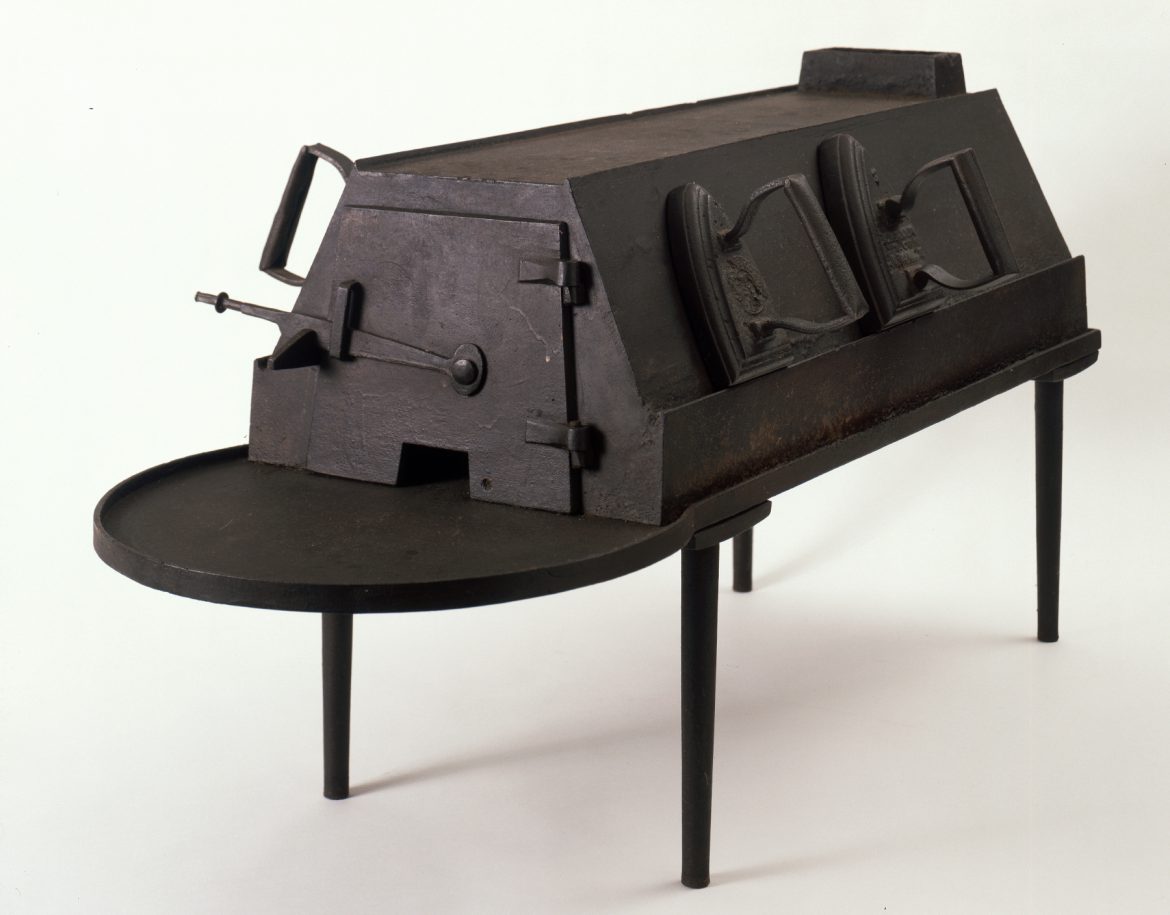
Ironing Stove, South Family, Mount Lebanon, NY, ca. 1840. Shaker Museum | Mount Lebanon, 1950.749.1.
Shakers generally designed their own stoves. Once a design was completed, a cabinetmaker made a wooden pattern. The pattern was taken to a foundry where one or more stoves were cast in iron. When the castings were retrieved Shaker blacksmiths and mechanics would do the finishing work – making door latches and hinges and sealing the […]

Ironing Stove, South Family, Mount Lebanon, NY, ca. 1840. Shaker Museum | Mount Lebanon, 1950.749.1.
Shakers generally designed their own stoves. Once a design was completed, a cabinetmaker made a wooden pattern. The pattern was taken to a foundry where one or more stoves were cast in iron. When the castings were retrieved Shaker blacksmiths and mechanics would do the finishing work – making door latches and hinges and sealing the pieces to make the stove airtight.

Photograph, Ironing Stove with Doors Open, Ironing Room, Church Family, Mount Lebanon, NY, William F. Winter, Photographer, ca. 1930. Shaker Museum | Mount Lebanon 1962.14115.1.
This stove was designed by the Shakers specifically for heating irons in their laundry. Sad irons, smoothing irons, flat irons, polishing irons, sleeve irons, collar irons, and tailors’ gooses – whatever they are called and however they are used – all have two things in common: they are heavy and must be re-heated often. The ironing stove has ledges cast into its sides that hold the back end of an iron so the flat part of the iron rests against the side of the hot stove. Two raised rails along the sides of the top are intended to hold larger irons – tailor’s gooses or sleeve irons – slightly above the top of the stove. The stove is long enough to hold two dozen irons. Irons needed to be exchanged frequently to keep them hot enough to be useful. Unlike blacksmithing, you probably cannot have “too many irons in the fire.” Exchanging hot for cool irons was often the work of young Shaker girls, who quickly learned how to use a pad to hold the hot handle and how to put the hot iron down on a trivet to keep from scorching the cloth on which ironing was being done.
This ironing stove in the Shaker Museum | Mount Lebanon collection was acquired by founder John S. Williams, Sr., from the South Family Shakers prior to 1946, when the property was purchased by Jerome and Sybil Count as the home for their Shaker Village Work Camp. This stove is un-cased, meaning there was no way of shielding the ironing crew from the heat of the stove in the summer. In Shakerism: Its Meaning and Message, Shaker authors White and Taylor tell of Brother George Wickersham’s invention of a summer covering – a casing – for Mount Lebanon’s Church Family’s ironing stove. The casing captured the heat radiating from the stove and vented it out of the room through a pipe that surrounded the regular stove pipe, keeping the ironing room cooler.

Photograph, Ironing Stove with Doors Closed, Ironing Room, Church Family, Mount Lebanon, NY, William F. Winter, Photographer, ca. 1930. Shaker Museum | Mount Lebanon 1962.14114.1.

Photograph, Ironing Stove with Doors Open, Ironing Room, Church Family, Mount Lebanon, NY, William F. Winter, Photographer, ca. 1930. Shaker Museum | Mount Lebanon 1962.14115.1.

Photograph (detail) , Ironing Stove, “Magnetic Lotus,” Wash House, North Family, Mount Lebanon, NY, William F. Winter, Photographer, ca. 1930. Shaker Museum | Mount Lebanon 1962.14094.1.
Fortunately, the ironing room in the 1879 wash house renovation at the North Family at Mount Lebanon had very high ceilings to help keep the room cooler since the Shakers did not select a cased stove for the room. They purchased an ironing stove called the “Magnetic Lotus” that was not cased but did have a water tank above the fire chamber. The water chamber kept irons placed at a temperature that was more consistent than for irons placed directly against the firebox. In fitting out their new wash house ironing room the Shaker purchased laundry equipment from the Troy Washing Machine Company, in nearby, Troy, NY. That company did offer a cased stove in their 1892 catalogue but there is no evidence the Shakers purchased one.
The South Family ironing stove is on view with other artifacts of Shaker laundry at Shaker Museum | Mount Lebanon through October 10,2016 in the summer exhibition Wash: There is no dirt in heaven.